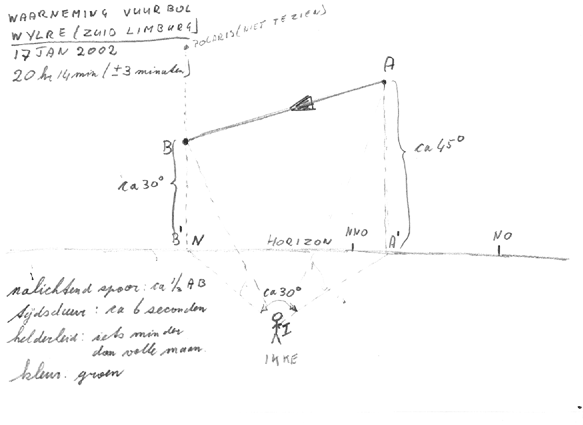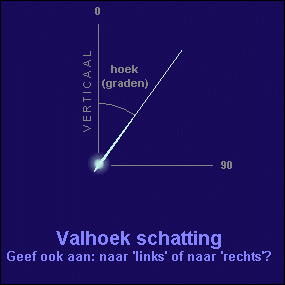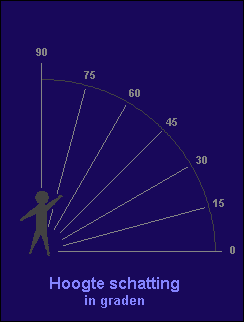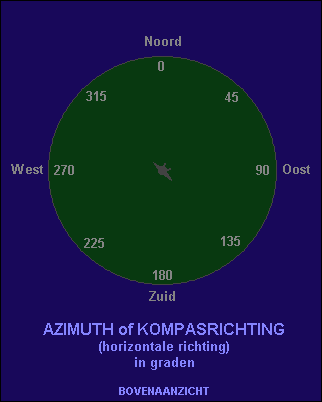A bright fireball has been sighted over parts of western-Europe on thursday evening january 17 at 19:15:22 UT. More detailed reports and maps showing the trajectory of the fireball will be published at this website.
A first report came in by experienced meteorobserver Paul van der Veen who noticed the fireball while on his bike to home.
We received another report from Timothy van der Linden from Utrecht.
After that yet some more reports have been received from Jo en Dana Meessen (via Marco Langbroek) from Wylre
(province of Zuid-Limburg) and an observer (via Remco Scheepmaker) from de Lutte, eastern part of the Netherlands.
Putting together the (few) observations from the Netherlands, Belgium and Germany including those begotten yesterday, the following picture emerges for the bright fireball of January 17. Especially the detailed Dusseldorf sighting turns out to be important. Note that I am now starting to doubt a meteorite fall.
Attached picture gives the current status of the reconstructed fireball trajectory. The endpoint has moved slightly north, to the area bounded by Venray, Cuijk and Veghel. The starting point is much less well defined. The crucial question is, whether it is the Dusseldorf or the Utrecht sighting of the fireball's starting point which is most deviating. Because Gelsenkirchen saw the fireball west, and Eindhoven noted movement from southeast to northwest, I tend to favour Dusseldorf over Utrecht. On the other hand, the altitude of the fireball at the reported Dusseldorf starting point appears too low.
The thick arrow is the trajectory I favour (Dusseldorf), the dashed thinner line north of it is what we get if we instead rely on Utrecht.
The altitude:
With the end-point where it now is situated, the altitude of extinguishing
shifts upward to about 50-60 km (Wylre 48 km, Rottem 60 km or lower
(depending on whether the ~45 degrees is the end altitude or a mean
altitude), Dusseldorf 60 km, Utrecht 70 km); making a meteorite dropping
less likely. Accuracy is not too well, and the true altitude still can be
from higher than 50 km, up to as low as 30 km.
The trajectory:
The trajectory I favour, points to a trajectory length of about 50 km. The
observations point to an average 3 seconds visibility (Wylre 6, Dusseldorf
4, Rottem 2-3, Eindhoven 2 and Utrecht 1 second). This points out that the
velocity was in order 15-25 km/s, but likely less than 20 km/s.
The time of appearance:
All times now quoted are, where appropriate, converted from MET to UTC (=MET-1). Rottem: 19:13, Wylre: 19:14, Utrecht
19:15, Eindhoven 19:15:22, Dusseldorf and Gelsenkirchen however 19:45 (!!).
The latter is hard to explain. Another fireball comes to mind, but then that would be highly unlikely...
The Eindhoven time would appear to be very accurate, but we don't know how well the watch of this observer was calibrated...
Some loose ends:
- Color - both Wylre and Dusseldorf report green, the others white (which is: just very bright green...).
- Fragmentation - Utrecht and Dusseldorf report fragmentation (Dusseldorf: "two pieces"), Wylre possible fragmentation. Thus: fragmentation: yes.
- Wylre reports a possible short persistent train.
- Nobody appears to have heard anything.
- All report: very bright, as bright or just slightly less than full moon, illuminating surroundings etc. This nothwithstanding thin cloud cover in the Netherlands.
A possible radiant:
the trajectory is too ill defined and we have to little
angle of descend estimates yet to arrive at a reliable indication. But if
the current favoured trajectory direction (~105 degrees) is correct then
Wylre gives the approximate entry angle, this being about 15, maybe 20
degrees with the horizontal. That yields a radiant just southeast of
Procyon, in the Canis minor-Cancer area. This is quite well where the delta
Cancrid radiant is located, which are active around 17 January, but the
velocity appears to be a bit slow (but admittedly is ill defined, and the
upper limit of the earlier quoted velocity 'window' is close to the 28 km/s
for delta Cancrids). Interestingly, it is also quite near the 2001 YB5
radiant, the Earthcrossing asteroid which had a very close approach to Earth
10 days earlier. I think the latter is most likely coincidence, however.
Additional observations are still welcome.
If the picture we now have changes significantly because of new information, I will communicate again.
Otherwise, these are end results. I think we can savely go from "dropper allert red" to a more quiet
"standby for eventualities, but nothing really expected".
- Marco Langbroek
Dutch Meteor Society (DMS)
www.dmsweb.org

Note the red lines point to the beginning of the meteor and the yellow lines point to the end as observed from various locations.
| Date | Thursday, January 17, 2002 |
|---|---|
| Time | 19:15:22 UT +/- 2 sec (timing by experienced DMS meteorobserver Paul van der Veen) |
| Duration | Paul estimates about 2 seconds while mr. Meessen estimates about 6 seconds duration |
| Magnitude | from -10 to possibly -15 |
| Color(s) | white, but green has been reported too |
| Location | reports have been received from the southern parts and from the center of the Netherlands |
| Entrance angle | at this moment still difficult to determine, we are working on this |
| Velocity | using the observational report of Paul van der Veen a very first estimate comes on 30 km/sec but this number is still highly uncertain! |
| Stream | unknown, we are working on this |
| Trail | difficult to determine because of lots of clouds |
| Persistent train | the observer in Wylre reports a short duration persistent train |
| Fragmentation | observed by some observers |
| Sounds | no sounds are reported |
| Spacedebris | highly unlikely because of very short duration and the movement of the fireball from a eastern to western direction |
| Sightings | the fireball is reported from the Netherlands. We are waiting for reports from other countries. |

The observation of Mr. Jo Meessen and his daughter Dana from Wijlre which is in the southern part of the province of Limburg.
Erik Froyen from Rotem, eastern Limburg, Belgium reports an almost identical trajectory of the fireball as Jo and Dana Meessen from Wijlre.
From these observations Marco Langbroek suggested the fireball appeared above the border of Germany and the Netherlands near the river Rhine.



- Bright fireball of 17 January 2002 (Marco Langbroek)
- How to report a fireball (Marco Langbroek, in Dutch)
- IMO Fireball Data Center
- NAMN Fireball Report Form
- Archive of DoD Press Releases by Peter Brown
- Infrasound measurements on fireballs by Läslo Evers (Royal Netherlands Meteorological Institute)
- Seismic Data Analysis Center, Hannover, Germany
- Infrasound Monitoring Research, Nuclear Explosion Monitoring Research and Engineering (NEM R&E) Program, DOE
- Infrasonic and Near Infrasonic Atmospheric Sounding and Imaging, NOAA/ERL, Boulder, Colorado
- Infrasound at the Swedish Institute of Space Physics, Umeå Division
- Infrasound recordings of bolides and explosions by Jessie Bonner, Paul Golden and Eugene Herrin